By Julian Bonnici, Daiva Repečkaitė and Sabrina Zammit
Photo credit: Joanna Demarco
- Malta’s population rose by 100,000 in a decade, while tourism doubled, straining public order and services.
- Police numbers barely grew, up just 32 since 2017 despite sharp population and tourism increases.
- Frontline ranks shrank, with fewer district constables and more civilian or reserve staff.
- Officer shortages are acute — in Sliema, Msida, and Gzira, one officer serves about 700 residents.
- Paceville and other hotspots lack stations, as reports in St Julian’s rose by over 40% since 2020.
- Police spending more than doubled to €117 million in 2025, driven by overtime and allowances, not new hires.
- Overtime costs jumped 860% in ten years, while staff numbers stayed flat.
- Community policing covers little ground, with just 129 officers across 25 localities.
- Migrants face language and trust barriers, limiting access to justice and protection.
- Court delays persist, leaving victims and migrant families without case updates or closure.
Malta’s population has swelled by more than 100,000 in the past decade, fuelled largely by migration. One in five residents is foreign, while record levels of tourism add further pressure.
Yet investment in policing and enforcement has not kept pace. Despite a ballooning budget dominated by overtime and allowances, the number of officers serving communities has remained largely unchanged, leaving districts overstretched. Meanwhile, residents, both local and migrant, have concerns over safety and security.
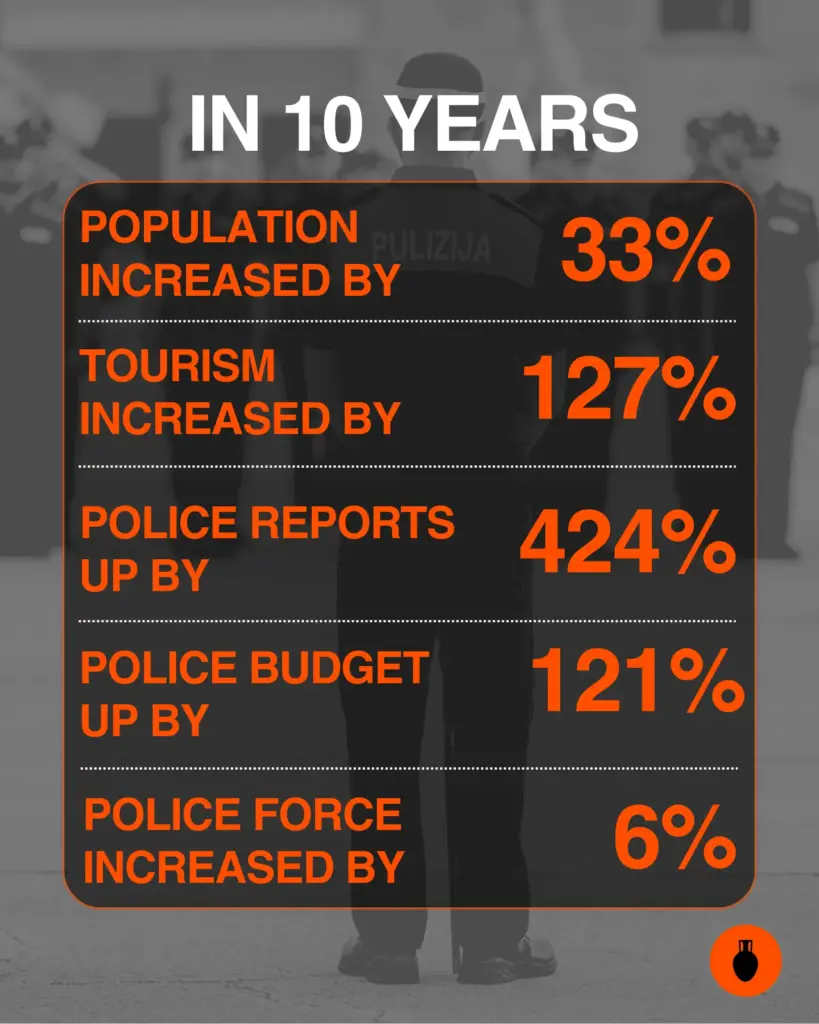
As of November 2024, Malta’s police force employed 2,405 people, just 32 more than in 2017, and about 500 more than in 2004, when the population was roughly 400,000.
As of November 2024, Malta’s police force employed 2,405 people, 469 more than in 2004, when the population was roughly 400,000.
In contrast, Malta’s estimated population now stands at approximately 574,000, with migration driving the current increase.
Tourism has also doubled in the past eleven years: inbound visitors rose from 1.5 million in 2013 to 3.5 million in 2024, adding an average of 62,000 extra people to the country every day.
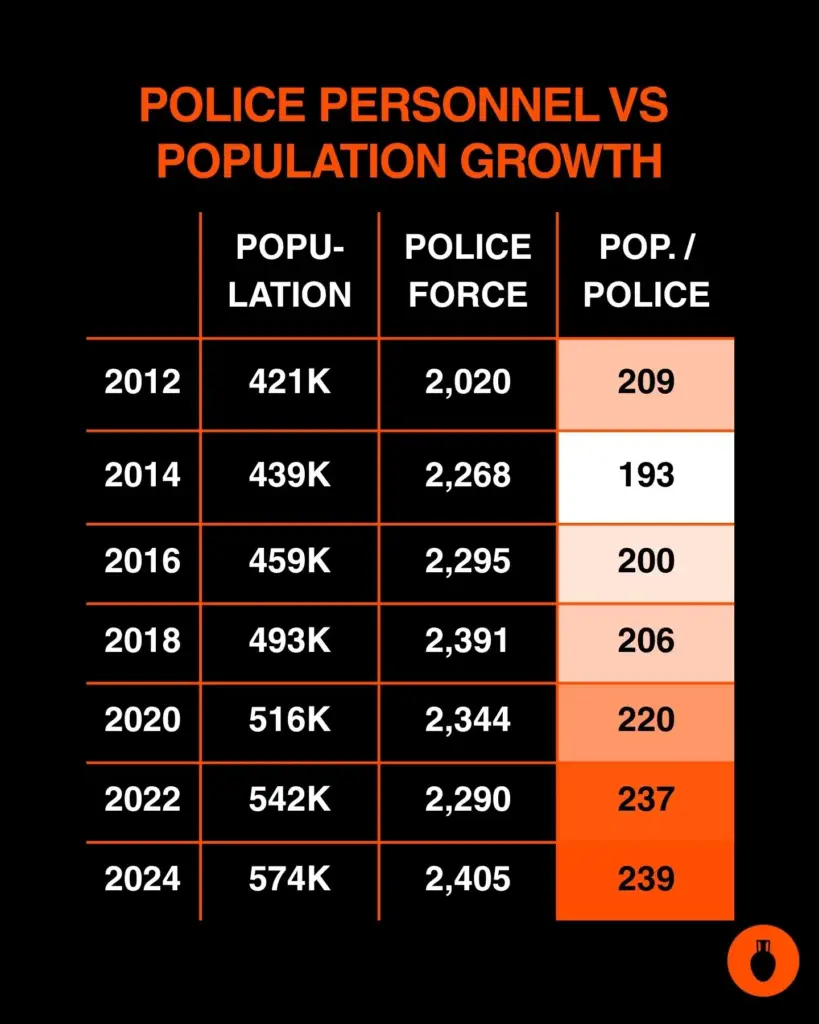
The strain is most visible at the community level. In Sliema, Msida, and Gżira, grouped as Police District 7, 67 officers serve nearly 50,000 residents, excluding the thousands of tourists who stay there during their holidays.
That works out to roughly one police officer for every 700 residents, a ratio that stretches even further during the summer influx of tourists.
Police District 7 is not an exception. Ħamrun and Marsa, grouped with Pietà and Santa Venera in Police District 2, have 56 officers for almost 32,200 residents, or about one officer for every 575 people.
“If I had to mention something that is lacking in our locality, it’s the absence of a police station. One officer on his own can’t keep up with everything, but still a police station would create more security among residents,” Pietà’s mayor Stefano Savo told Amphora.
Other areas fare even worse. In Gozo, the number of district officers across the island has actually decreased by 51 over 10 years. And it’s a thankless job, says Victoria’s mayor Brian Azzopardi.
“If a policeman does his job, he only gets insults in return,” he told Amphora Media.
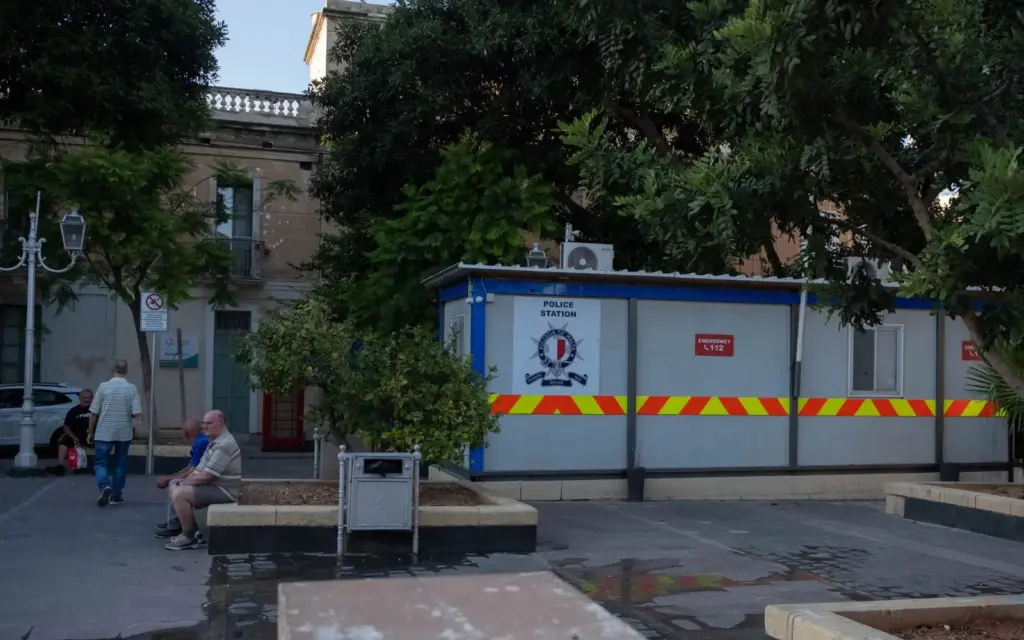
In St Julian’s, which has seen heavy migration and bears the brunt of over-tourism, officers must also police Paceville, Malta’s nightlife hub, notorious on TikTok for videos of fights, vandalism, and public urination.
Yet Paceville has no police station of its own. Instead, the St Julian’s district station serves as the first point of contact for residents, even though its officers are not formally tasked with policing Paceville.
St Julian’s and Swieqi fall under the same police district, yet between 2013 and 2025, the number of officers assigned there fell by four. This decline comes despite a sharp rise in demand: police reports in the district increased by more than 2,600, from 5,937 in 2020 to 8,607 in 2024.
Valletta, which has become its own entertainment hub in the years before and following V18, also faces similar shortages. From 2013 to 2025, the number of officers within its police district fell by 32, despite reports increasing by 797.
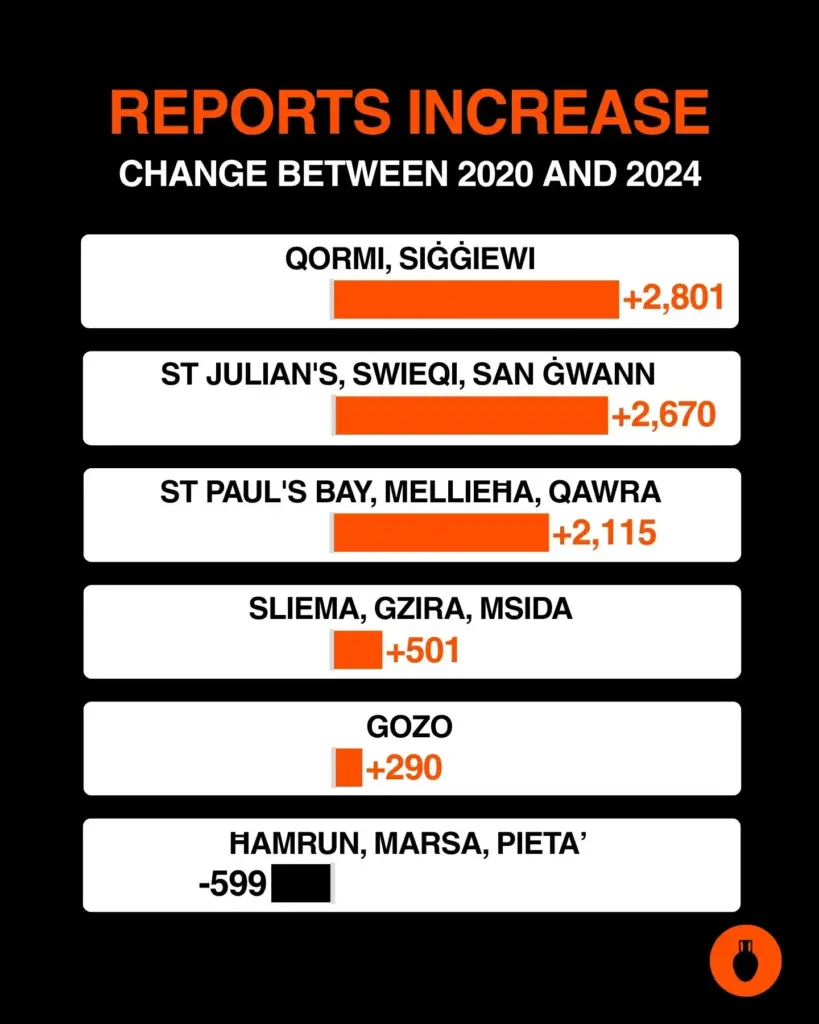
Shifts in the composition of the force have also weakened frontline enforcement.
Between 2013 and 2023, the number of police officer ranks grew by 434, primarily driven by sharp increases in civilian officers (+238) and reserve constables (+208). In 2013, there were no civilian officers and one reserve constable serving in the force. Numbers of inspectors and sergeants also rose, but the force lost 137 district police constables.
Overall, district police numbers fell by 153, with only Qormi-Siġġiewi-Żebbuġ (+24) and Birkirkara-Balzan-Attard-Naxxar (+15) recording increases.
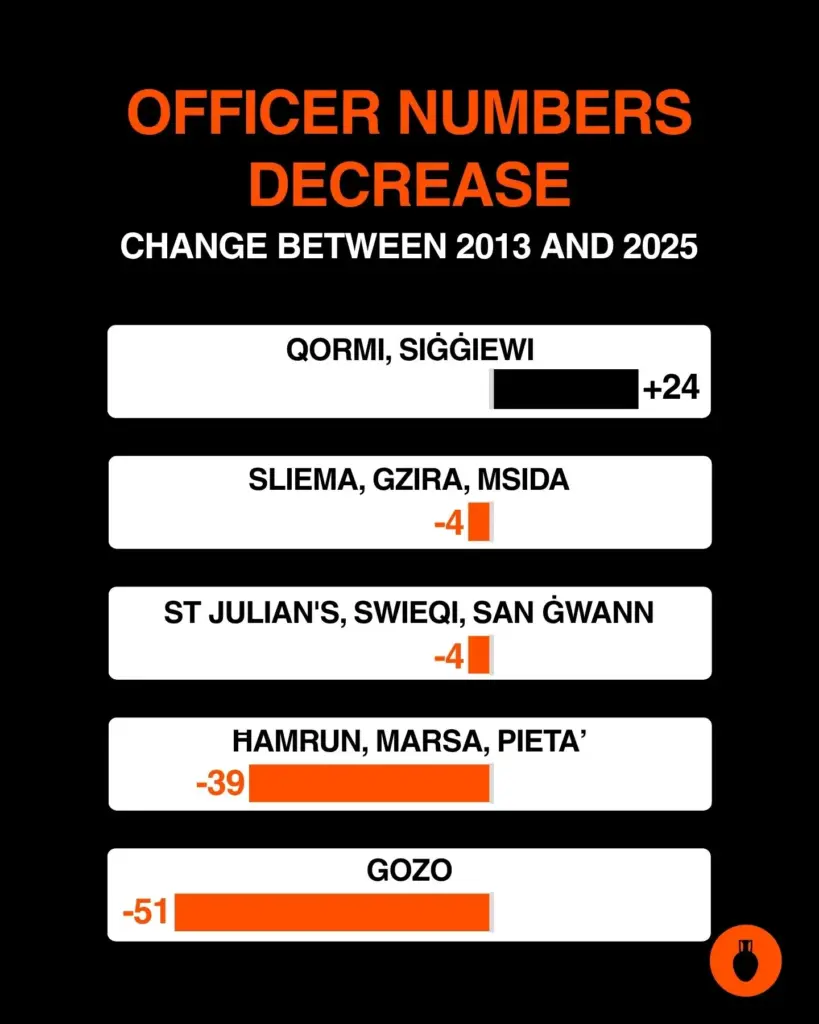
Despite this, the money being spent on policing has soared.
The 2025 police budget is set at €117.3 million, more than double the €53 million spent in 2013. Most of the growth came after 2018, when the budget stood at near €70 million.
Government budgetary documents indicate that the surge is primarily driven by rising overtime, allowances, and salaries, despite the police workforce expanding by only 14 personnel between 2018 and 2024.
Overtime costs have soared from €1.3 million in 2013 and €4.2 million in 2018, to a projected €12.5 million in 2025, an 860%% increase in a decade.
Allowances have more than doubled, from around €12.2 million in 2018 to an estimated €23.95 million in 2025, while salaries rose from €42.4 million to €58.8 million over the same period.
The government also generously spends on private security firms.
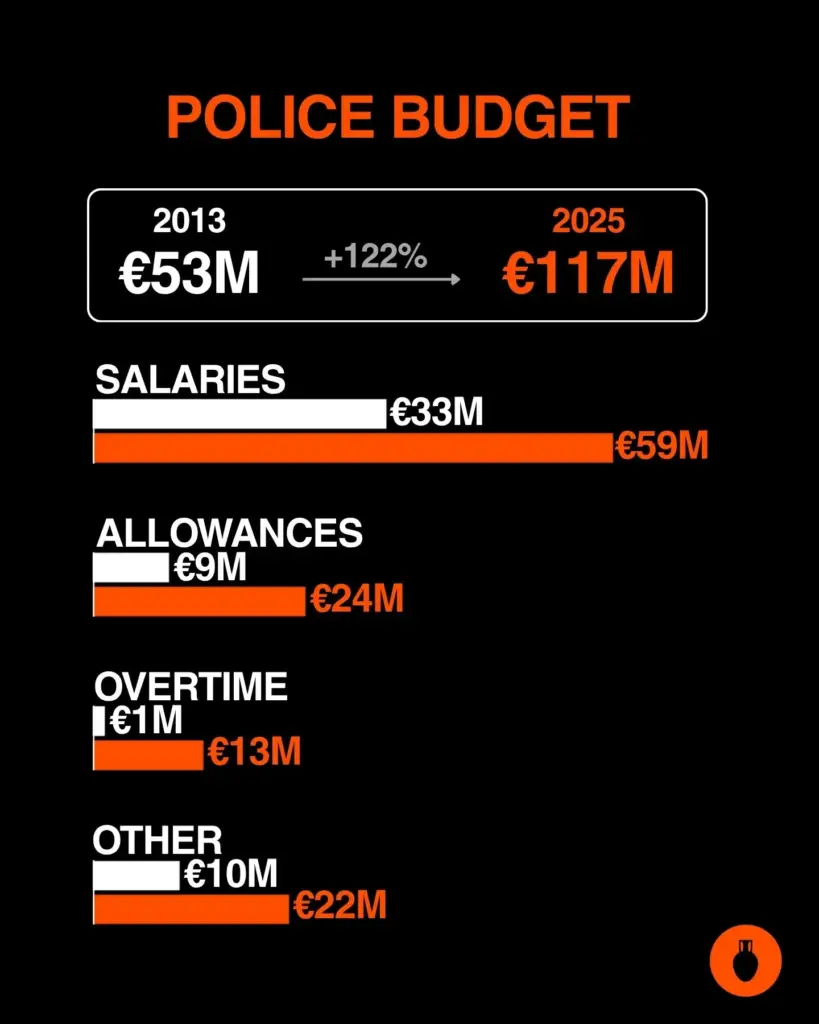
At the same time, police workload has increased sharply.
Reports have been steadily rising, with more than 85,000 filed in both 2023 and 2024. With 731 district officers across Malta and Gozo, that averages out to roughly 115 reports per officer each year.
Introducing Community Police to Address Gaps
Authorities have sought to plug enforcement gaps with the introduction of community police officers, 129 of whom are deployed across 25 localities, resulting in a rate of one community police officer for every 4,027 residents.
Sliema has just three community officers, while St Julian’s has five. Ħamrun, Marsa, Santa Venera, and Pietà share nine between them; Msida, Gżira, and Ta’ Xbiex have four; Marsaskala also has five; and Birżebbuġa and Marsaxlokk share five.
The entire island of Gozo has 12 community police officers.
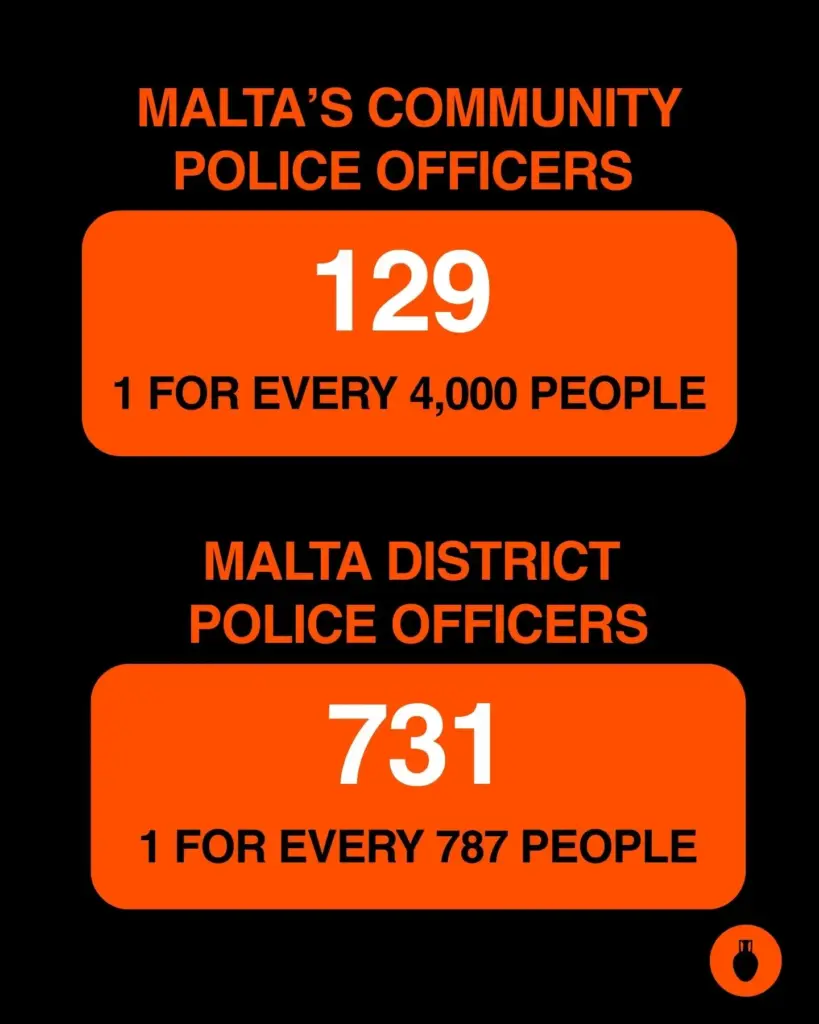
Umayma Elamin from the Migrant Women’s Association, based in Hamrun, praised the community policing programme, saying it has helped bridge the gap between migrants and authorities on local issues and has already facilitated meetings that bring the two communities closer together.
“I’d like to see more police in the streets—to control the situation and make people aware that someone is watching them. So people become more conscious of their behaviour,” Gżira mayor Neville Chetcuti told Amphora.
Umayma Elamin further explained that many victims of gender-based or sexual violence are reluctant to approach the police directly.
Without proper translators, Umayma says, authorities are unable to help victims of serious crimes effectively.
“I feel even if translated, there is still a lack of training when dealing with the victim,” she said.
In a document sent to the Council of Europe, the government stated that “Police personnel undergo cultural competence training to enhance their ability to effectively communicate and engage with individuals from various ethnic, religious, and socioeconomic backgrounds.” Additionally, it noted that an Arabic-speaking Muslim officer was recruited to work in Marsa.
No other examples of diverse recruitment in other localities were provided. Effective communication with migrant communities appears to remain an issue.
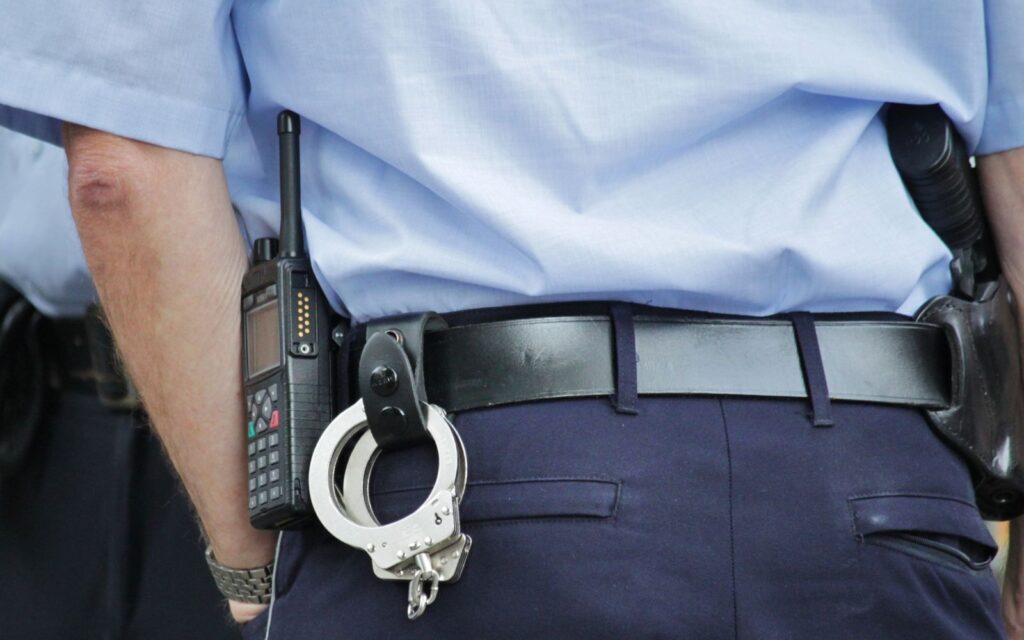
Enforcement without Justice
Ultimately, enforcement is little without an efficient justice system. Like many Maltese residents, migrants also struggle with the country’s legal system, which suffers from some of the worst delays in Europe.
Speaking to Amphora Media, representatives of the Nepal Malta Charity Organisation stated that while interactions with authorities are often positive, the justice system’s lengthy delays and lack of communication create significant problems.
In recent years, several Nepalese nationals have died in Malta – most recently Khim Bahadur Pun, killed in a hit-and-run in August, and Gauri Kumari Baral, who died in January. Yet victims’ families and the wider community say they have received little to no information on the cases.
There have also been no updates on Ajay Shrestha, who died in 2020 when a truck overturned on Triq Aldo Moro and collided with his motorcycle.
Nepalese community representatives added that the safety of courier drivers remains a neglected concern. While some working conditions have improved, problems with unpaid wages, overtime, sick leave, and bonuses persist.
“Every day we are facing an accident, no one is taking responsibility.
This investigation was developed with the support of Journalismfund Europe.

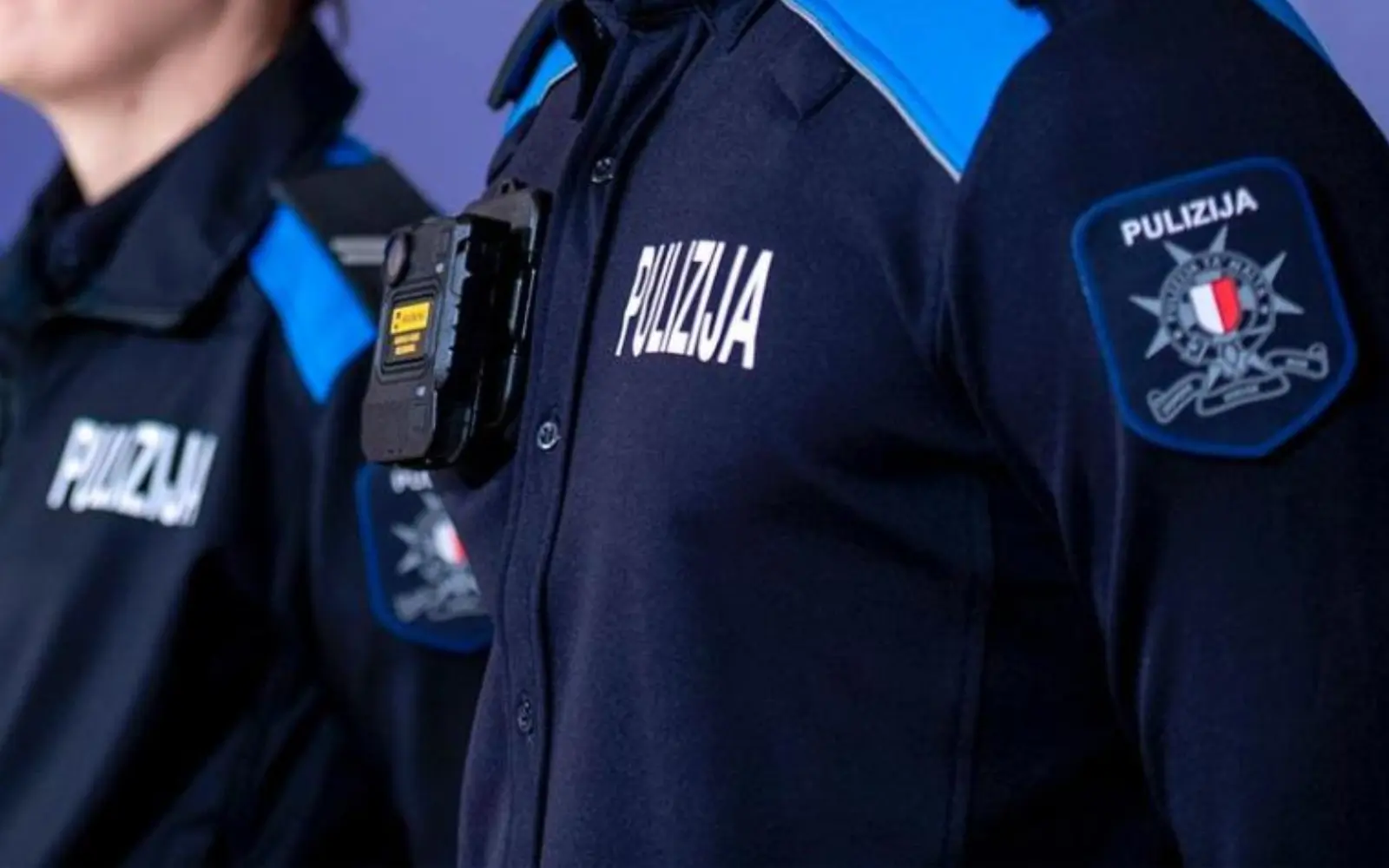
Leave a Reply